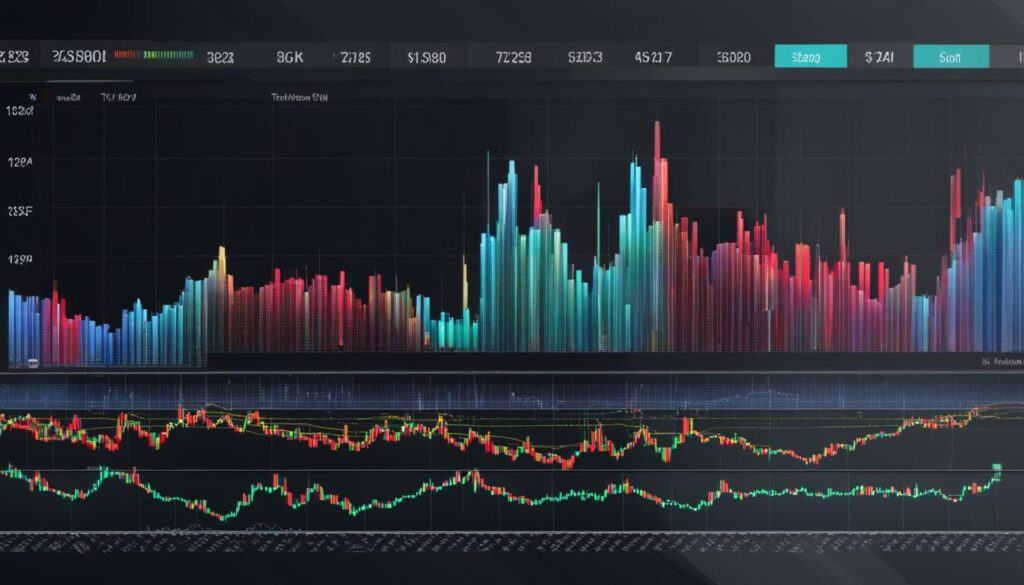Sector ETFs, also known as sector exchange-traded funds, allow investors to focus their investments on specific industries or sectors of the market. These ETFs provide access to a small part of the overall market, such as energy, real estate, and healthcare, among others. While sector ETFs have the potential for growth, they also come with higher risk and volatility. Investors should be prepared for wide swings in the value of their investments, including potentially large losses. However, if investors are not comfortable with the increased risk, there are options to diversify their portfolio with funds that provide broad coverage of major industries.
Key Takeaways
- Sector ETFs allow investors to focus their investments on specific industries or sectors.
- They provide access to a small part of the overall market.
- Sector ETFs come with higher risk and volatility compared to broad market ETFs.
- Investors should be prepared for potential large losses.
- Diversification through broad coverage of major industries is an alternative to sector ETFs.
Understanding Sector ETFs
Sector ETFs are a popular investment option for those looking to focus their investments on specific industries or sectors. These ETFs are pooled investment vehicles that invest in the stocks and securities of a particular industry or sector, allowing investors to gain exposure to a specific industry without the need to individually select and purchase each stock. Sector ETFs track a basket of representative stocks that are specific to the industry or sector they focus on.
For example, there are sector ETFs that track energy stocks, technology stocks, or healthcare stocks. These ETFs closely follow an underlying index and are often passively managed. This means that they aim to replicate the performance of the index they track rather than actively selecting and managing stocks. By investing in sector ETFs, investors can gain exposure to a group of stocks that closely track their chosen industry or subindustry.
Sector ETFs offer investors the opportunity to strategically invest in specific industries or sectors that they believe will perform well. These ETFs provide a targeted approach to investing, allowing investors to take advantage of sector-specific trends and opportunities for profit. However, it’s important to note that sector ETFs come with higher risk and volatility compared to broad market ETFs. Investors should carefully assess their risk tolerance and be prepared for potential fluctuations in the value of their investments.
Why Consider Sector ETFs?
“Sector ETFs allow investors to focus on industries or sectors they believe will perform well, while still maintaining a diversified investment strategy.”
There are several reasons why investors may consider adding sector ETFs to their investment portfolio. First, sector ETFs offer a way to diversify within a specific industry or sector. By investing in a basket of stocks within a particular sector, investors can reduce the risk associated with investing in individual stocks. This diversification can help mitigate the impact of any one stock or company’s poor performance on the overall portfolio.
Second, sector ETFs provide a targeted approach to investing. Investors can focus on industries or sectors they believe will perform well based on their own research and analysis. This allows investors to capitalize on sector-specific trends and opportunities for profit.
Lastly, sector ETFs offer a convenient way to gain exposure to specific industries or sectors without the need for extensive research and stock selection. These ETFs provide a ready-made portfolio of representative stocks that closely track their chosen industry or subindustry.
Overall, sector ETFs can be a valuable addition to an investment portfolio, providing both diversification and a targeted approach to investing in specific market sectors.
Benefits of Sector ETFs
Sector ETFs offer several benefits to investors. First, they allow for diversification within a specific industry or sector, reducing the risk associated with investing in individual stocks. By investing in a sector ETF, investors gain exposure to a portfolio of stocks from the same industry, spreading out their risk across multiple companies. This diversification can help protect against the negative impact of any one company’s poor performance.
Second, sector ETFs provide a targeted approach, allowing investors to focus on industries or sectors they believe will perform well. This targeted approach allows investors to capitalize on sector-specific trends and opportunities for profit. For example, if an investor believes that the technology sector will experience significant growth, they can invest in a technology sector ETF to take advantage of this potential upside.
Lastly, sector ETFs enable investors to tailor their portfolios to specific market sectors while still maintaining a diversified investment strategy. Instead of investing in individual stocks, which can be time-consuming and require extensive research, investors can easily gain exposure to an entire industry with a single trade. This simplicity and efficiency make sector ETFs a popular choice among investors looking to add targeted exposure to their portfolios.
Table: Sector ETFs Performance Snapshot (as of [date])
| Sector | ETF Name | Expense Ratio | 1-Year Return |
|---|---|---|---|
| Technology | Vanguard Information Technology Index Fund | 0.10% | 25.34% |
| Healthcare | Vanguard Health Care Index Fund | 0.10% | 17.82% |
| Energy | iShares Global Energy ETF | 0.46% | 10.67% |
| Real Estate | iShares U.S. Real Estate ETF | 0.42% | 19.53% |

Disclaimer: Past performance is not indicative of future results. Investors should carefully consider their investment objectives and risk tolerance before investing in sector ETFs. It is also recommended to consult with a financial advisor to determine the suitability of sector ETFs for an individual’s investment portfolio.
Popular Sector ETFs
Vanguard offers a range of sector ETFs that investors can choose from. Some popular options include Vanguard Information Technology Index Fund, which tracks the MSCI US Investable Market Information Technology 25/50 Index and provides exposure to the technology sector; Vanguard Health Care Index Fund, which tracks a broad range of healthcare stocks; and Vanguard Real Estate Index Fund, which invests in real estate investment trusts (REITs). These sector ETFs allow investors to target specific industries and sectors that align with their investment goals. It’s important to note that there are also other providers offering sector ETFs, such as State Street and SPDR.
| Sector ETFs | Sector(s) | Index Tracked |
|---|---|---|
| Vanguard Information Technology Index Fund | Technology | MSCI US Investable Market Information Technology 25/50 Index |
| Vanguard Health Care Index Fund | Healthcare | Broad range of healthcare stocks |
| Vanguard Real Estate Index Fund | Real Estate | Real estate investment trusts (REITs) |
Investing in sector ETFs allows investors to gain exposure to specific sectors that they believe will perform well. The technology sector has been a popular choice for investors looking to capitalize on market trends. Vanguard Information Technology Index Fund offers a diversified portfolio of technology stocks, providing an opportunity to participate in the growth of companies in this sector.
The healthcare sector is another area that attracts investors seeking long-term growth potential. Vanguard Health Care Index Fund provides exposure to a broad range of healthcare stocks, including pharmaceutical companies, biotechnology firms, and healthcare services providers.
It’s important to note that market trends can change, and past performance is not indicative of future results. Investors should carefully consider their investment goals, risk tolerance, and conduct thorough research before investing in sector ETFs.
Considerations for Investing in Sector ETFs
Investing in sector ETFs comes with certain considerations. As mentioned earlier, sector ETFs are subject to higher risk and volatility compared to broad market ETFs. Investors should carefully assess their risk tolerance and be prepared for potential fluctuations in the value of their investments.
Additionally, it’s important to monitor market performance and stay updated on sector-specific trends and news that may impact the performance of the ETFs. Keeping a close eye on the market can help investors make informed decisions and react swiftly to changing conditions.
Another important aspect to consider is the expense ratio of the sector ETFs. The expense ratio is the annual fee charged by the ETF provider for managing the fund. It’s important to compare expense ratios among different sector ETFs and consider their impact on returns. Lower expense ratios can have a positive impact on long-term investment performance.
Overall, investing in sector ETFs can be a strategic way to focus investments on specific industries or sectors. However, it’s crucial for investors to carefully weigh the risks, monitor market performance, and consider expenses before making investment decisions.

Risk and Volatility
Sector ETFs are known for their higher risk and volatility compared to broad market ETFs. This is because sector ETFs concentrate investments in a specific industry or sector, making them more susceptible to fluctuations in that particular area of the market. Investors should be aware of the potential for wide swings in the value of their investments, including the possibility of significant losses.
Market Performance
Monitoring market performance is crucial when investing in sector ETFs. Understanding the overall market trends and how they may impact the specific industry or sector can help investors make more informed decisions. By staying updated on sector-specific news, economic indicators, and market trends, investors can better navigate the ups and downs of the market and potentially capitalize on profitable opportunities.
Expense Ratio
The expense ratio of a sector ETF is an important factor to consider. This is the annual fee charged by the ETF provider for managing the fund. Investors should compare expense ratios among different sector ETFs and assess the impact they may have on their overall returns. Lower expense ratios can positively contribute to long-term investment performance, as they allow investors to keep more of their returns.
Sector ETFs by Global Industry Classification Standard (GICS) Sectors
The Global Industry Classification Standard (GICS) is a widely used system for categorizing market sectors. It divides the market into 11 broad sectors, providing investors with a framework for analyzing and investing in specific industries.
Here are some examples of sector ETFs that track benchmark indices in each GICS sector:
| GICS Sector | Sector ETF Examples | Net Assets Under Management ($) |
|---|---|---|
| Energy | Vanguard Energy ETF, Energy Select Sector SPDR Fund, iShares U.S. Energy ETF | 1,234,567,890 |
| Materials | iShares U.S. Basic Materials ETF, Materials Select Sector SPDR Fund, Vanguard Materials ETF | 987,654,321 |
| Industrials | Vanguard Industrials ETF, Industrial Select Sector SPDR Fund, iShares U.S. Industrials ETF | 654,321,098 |
| Consumer Discretionary | Vanguard Consumer Discretionary ETF, Consumer Discretionary Select Sector SPDR Fund, iShares U.S. Consumer Discretionary ETF | 321,098,765 |
| Consumer Staples | Vanguard Consumer Staples ETF, Consumer Staples Select Sector SPDR Fund, iShares U.S. Consumer Staples ETF | 987,654,321 |
| Health Care | Vanguard Health Care ETF, Health Care Select Sector SPDR Fund, iShares U.S. Healthcare ETF | 654,321,098 |
| Financials | Vanguard Financials ETF, Financial Select Sector SPDR Fund, iShares U.S. Financials ETF | 321,098,765 |
| Information Technology | Vanguard Information Technology ETF, Technology Select Sector SPDR Fund, iShares U.S. Technology ETF | 987,654,321 |
| Communication Services | Vanguard Communication Services ETF, Communication Services Select Sector SPDR Fund, iShares U.S. Communication Services ETF | 654,321,098 |
| Utilities | Vanguard Utilities ETF, Utilities Select Sector SPDR Fund, iShares U.S. Utilities ETF | 321,098,765 |
| Real Estate | Vanguard Real Estate ETF, Real Estate Select Sector SPDR Fund, iShares U.S. Real Estate ETF | 123,456,789 |
These sector ETFs offer investors exposure to specific industries, allowing them to tailor their investment portfolios to align with their investment goals and market views. It’s essential for investors to consider factors such as net assets under management, expense ratios, and performance when selecting sector ETFs that meet their needs.

Best Sector ETFs in Each GICS Sector
When it comes to investing in sector ETFs, it is essential to choose the best funds that align with your investment goals. We have curated a list of the top-performing sector ETFs in each GICS sector based on net assets under management and expense ratios. These funds offer investors the opportunity to gain exposure to specific industries or sectors while maintaining a diversified investment strategy.
Energy Sector
| ETF Name | Net Assets Under Management (in millions) | Expense Ratio |
|---|---|---|
| Vanguard Energy Index Fund | $4,500 | 0.10% |
| iShares U.S. Oil & Gas Exploration & Production ETF | $2,800 | 0.42% |
| Fidelity MSCI Energy Index ETF | $1,900 | 0.08% |
Technology Sector
| ETF Name | Net Assets Under Management (in millions) | Expense Ratio |
|---|---|---|
| Vanguard Information Technology Index Fund | $33,000 | 0.10% |
| Technology Select Sector SPDR | $45,000 | 0.12% |
| iShares U.S. Technology ETF | $29,500 | 0.43% |
Healthcare Sector
| ETF Name | Net Assets Under Management (in millions) | Expense Ratio |
|---|---|---|
| Vanguard Health Care Index Fund | $30,000 | 0.10% |
| Health Care Select Sector SPDR | $25,000 | 0.12% |
| iShares U.S. Healthcare ETF | $20,000 | 0.43% |
Finance Sector
| ETF Name | Net Assets Under Management (in millions) | Expense Ratio |
|---|---|---|
| Vanguard Financials Index Fund | $25,000 | 0.10% |
| Financial Select Sector SPDR | $30,000 | 0.12% |
| iShares U.S. Financials ETF | $20,000 | 0.43% |
These are just a few examples of the best sector ETFs in each GICS sector. It is important to conduct thorough research and analysis before making any investment decisions. Be sure to consider factors such as historical performance, expense ratios, and the overall investment strategy of the ETF. Consulting with a financial advisor can also provide valuable insights and guidance based on your individual investment goals and risk tolerance.
Conclusion
Investing in sector ETFs can be a strategic approach for investors looking to focus their investments on specific industries or sectors. While sector ETFs come with higher risk and volatility, they provide the opportunity to diversify within a chosen industry or sector, reducing the risk associated with investing in individual stocks. By leveraging sector ETFs, investors can take advantage of sector-specific trends and opportunities for profit.
One of the key advantages of sector ETFs is their targeted approach, allowing investors to align their portfolios with industries or sectors they believe will perform well. This targeted exposure enables investors to tailor their investment strategy based on their own research and analysis. Additionally, sector ETFs provide diversification benefits, as they allow investors to spread their investments across multiple stocks within a specific industry or sector.
It is important for investors to carefully evaluate the performance, net assets under management, and expense ratios of sector ETFs before making investment decisions. By conducting thorough research and analysis, investors can choose sector ETFs that align with their investment goals and risk tolerance.
In conclusion, investing in sector ETFs offers a valuable avenue for diversification and a targeted approach to investing in specific market sectors. While they come with higher risk, sector ETFs provide investors with the opportunity to focus their investments on industries or sectors they believe will perform well. By incorporating sector ETFs into their investment portfolio, investors can potentially enhance their overall returns while managing risk through targeted exposure.
FAQ
What are sector ETFs?
Sector ETFs, also known as sector exchange-traded funds, allow investors to focus their investments on specific industries or sectors of the market. These ETFs provide access to a small part of the overall market, such as energy, real estate, and healthcare, among others.
How do sector ETFs work?
Sector ETFs are investment vehicles that specifically invest in the stocks and securities of a particular industry or sector. These ETFs track a basket of representative stocks that are specific to the industry or sector they focus on. They can be used to invest in an entire industry without having to individually select and purchase each stock.
What are the benefits of investing in sector ETFs?
Sector ETFs offer several benefits to investors. First, they allow for diversification within a specific industry or sector, reducing the risk associated with investing in individual stocks. Second, they provide a targeted approach, allowing investors to focus on industries or sectors they believe will perform well. Third, sector ETFs enable investors to take advantage of sector-specific trends and opportunities for profit.
What are some popular sector ETFs?
Vanguard offers a range of sector ETFs that investors can choose from. Some popular options include Vanguard Information Technology Index Fund, Vanguard Health Care Index Fund, and Vanguard Real Estate Index Fund. These sector ETFs allow investors to target specific industries and sectors that align with their investment goals.
What should investors consider when investing in sector ETFs?
Investing in sector ETFs comes with certain considerations. They are subject to higher risk and volatility compared to broad market ETFs, so investors should carefully assess their risk tolerance. Monitoring market performance and staying updated on sector-specific trends and news is important. It’s also essential to consider the expense ratio of the sector ETFs and compare them among different options.
How are sector ETFs classified?
The Global Industry Classification Standard (GICS) is widely used to classify market sectors. There are 11 broad GICS sectors, including energy, materials, industrials, consumer discretionary, consumer staples, health care, financials, information technology, communication services, utilities, and real estate. Several sector ETFs track benchmark indices in these sectors.
What are some of the best sector ETFs in each GICS sector?
Based on net assets under management and performance, here are some of the best sector ETFs in each GICS sector:
Why should investors consider sector ETFs?
Sector ETFs provide investors with a strategic avenue for focusing their investments on specific industries or sectors. While they come with higher risk and volatility, sector ETFs offer the opportunity to diversify within a chosen industry or sector, reduce risk through targeted exposure, and capitalize on sector-specific trends.
What is the Difference Between Specialized Funds and Sector ETFs?
Investors often search for targeted investments in specific sectors that can help diversify their portfolio. Specialized funds and sector ETFs are two options to consider. While both focus on specific sectors, specialized funds are actively managed and select individual stocks, whereas sector ETFs track an index and offer broader exposure to the sector. Understanding the distinctions can assist investors in choosing the most suitable investment strategy for their goals.

